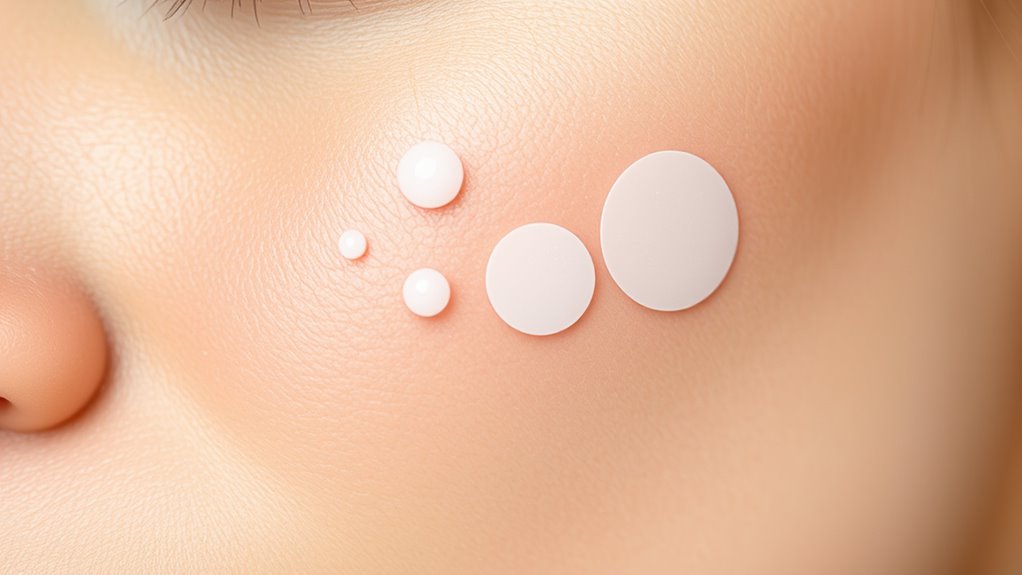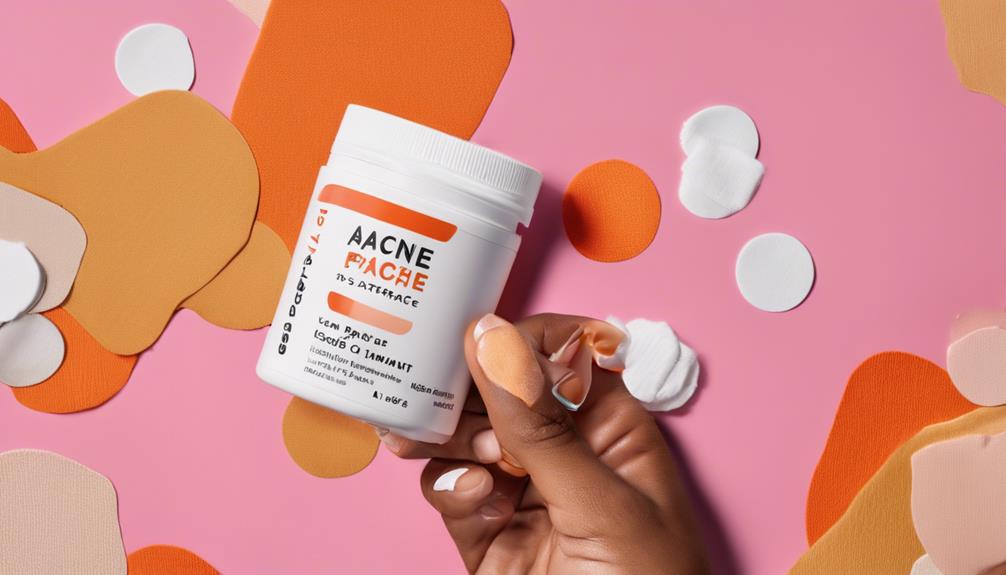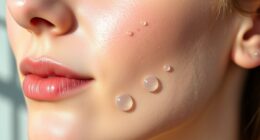Choosing the right patch size depends on the blemish or scar you want to treat. You should select a patch that fully covers the affected area with a small margin, ensuring all affected tissue gets medication and support. Avoid patches that are too small, which might leave parts untreated, or too large, causing discomfort. Proper sizing helps boost healing and effectiveness. Keep these tips in mind, and you’ll discover more ways to optimize your treatment ahead.
Key Takeaways
- Match the patch size closely to the blemish to ensure effective coverage and absorption.
- Use small patches for tiny blemishes to prevent waste and improve precision.
- Select larger patches for extensive scars to provide broad treatment coverage.
- Proper sizing prevents air bubbles, wrinkles, and irritation, promoting better healing.
- Follow manufacturer instructions on size and duration for optimal application and results.

Have you ever wondered how the size of a patch can impact its effectiveness? When it comes to scar healing and blemish treatment, choosing the right patch size is vital. A patch that’s too small might not cover the entire affected area, leaving parts untreated and slowing down the healing process. Conversely, a patch that’s too large can be unnecessary and cumbersome, potentially causing discomfort or irritation. The key is to match the patch size to the specific blemish or scar you’re targeting, guaranteeing ideal contact and absorption.
Proper patch application techniques play a significant role in maximizing the benefits of your treatment. Before applying a patch, make sure the skin is clean and dry. Gently remove any oils or debris, as these can interfere with adhesion and reduce effectiveness. When placing the patch, guarantee it fully covers the scar or blemish with a slight margin around the edges. This helps prevent dirt or bacteria from entering and promotes better healing. Press down firmly to secure the patch smoothly against your skin, avoiding any air bubbles or wrinkles that could compromise adhesion or uniform medication delivery.
Ensure skin is clean and dry before applying patches for optimal adhesion and healing.
Choosing the right patch size also influences how well the treatment supports scar healing. A patch that matches the size of the scar ensures that the active ingredients are concentrated exactly where they’re needed most. If you’re dealing with a small blemish, opt for a tiny, precise patch to avoid wasting product and to keep the area as natural-looking as possible. For larger scars or more extensive blemishes, a bigger patch provides broader coverage, ensuring all affected tissue receives treatment and consistent healing support.
It’s worth noting that some patches are designed with flexibility in mind, allowing them to conform to different shapes and sizes. This flexibility can be especially helpful when dealing with irregular blemishes or scars. Additionally, always follow the manufacturer’s instructions regarding patch size and duration of application. Wearing a patch for too long or using an oversized patch unnecessarily can lead to irritation or hinder the scar healing process. Proper application techniques, combined with selecting the appropriate size, help maintain skin integrity and promote faster, more effective healing.
Frequently Asked Questions
How Do Patch Sizes Vary for Different Skin Types?
When selecting patch sizes for different skin types, you should consider texture considerations and moisture absorption. For oily or textured skin, smaller patches work better to target specific blemishes without trapping excess oil. If your skin is dry or sensitive, larger patches with gentle adhesives help maintain moisture absorption and protect delicate areas. Always choose a size that matches your skin’s needs, ensuring effective treatment without causing irritation or discomfort.
Can Patch Size Influence Healing Time?
You might wonder if patch size influences healing time, and it does. Larger patches can enhance patch size effectiveness by covering more blemish, but they may also extend healing duration, as the skin needs more time to recover. Smaller patches target specific areas, often leading to quicker healing. So, choosing the right size balances patch size effectiveness with your desired healing duration, ensuring your skin heals efficiently and effectively.
Are Larger Patches Suitable for All Blemish Types?
Larger patches aren’t suitable for all blemish types because patch size aesthetics and durability vary. For smaller spots, a compact patch offers a discreet look and stays secure without irritation. Bigger patches might be more durable but can be less discreet, drawing unwanted attention. Always match patch size to your blemish’s size and location, balancing aesthetics with durability to guarantee effective healing and a natural appearance.
How Do I Choose the Right Patch Size for Sensitive Skin?
When it comes to sensitive skin, you need to tread carefully. To choose the right patch size, consider the adhesive strength—look for gentle, hypoallergenic options that won’t cause irritation. Material options like silicone or fabric patches are softer and more breathable, reducing discomfort. Start with a smaller size to avoid overwhelming your skin, then adjust if needed. Remember, patience is key—sometimes, less is more!
Do Patch Sizes Affect the Visibility of the Blemish?
Yes, patch size affects blemish visibility. When you choose a larger patch, it can cover more of the blemish, making it less noticeable. Conversely, smaller patches blend better with your skin, reducing visibility. If you want discreet coverage, opt for a patch that matches your skin tone and is slightly bigger than the blemish. This way, you effectively hide the blemish without drawing extra attention.
Conclusion
Remember, selecting the right patch size can make all the difference in your skincare routine. For example, if you have a stubborn pimple, using a patch slightly larger than the blemish ensures it stays covered and protected, speeding up healing. Imagine choosing a tiny patch for a larger breakout—you’re leaving it exposed and risking further irritation. So, always match the patch size to your blemish for maximum results and a smoother, clearer complexion.









